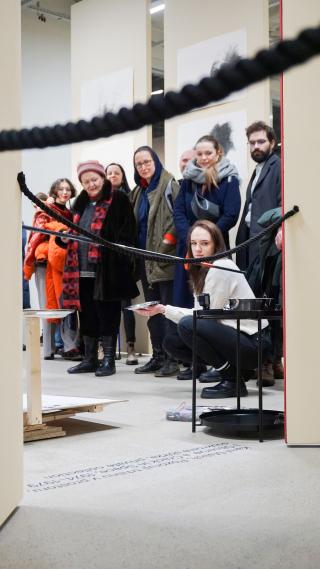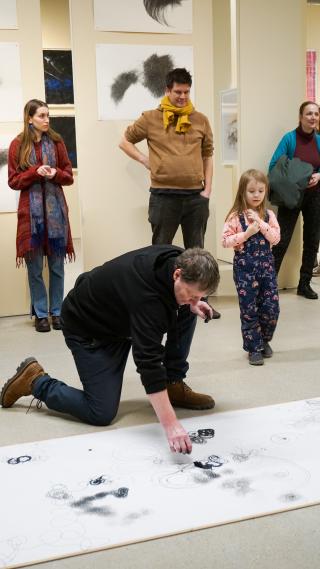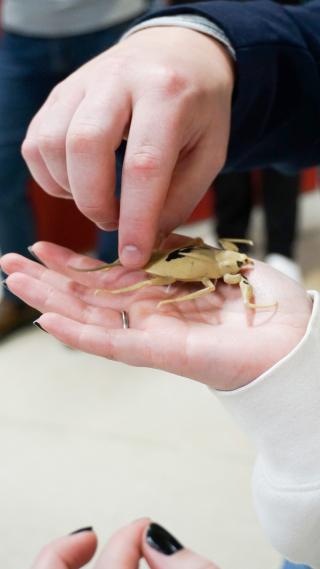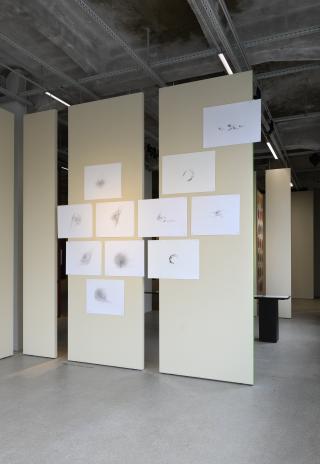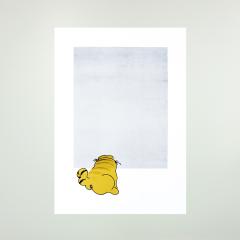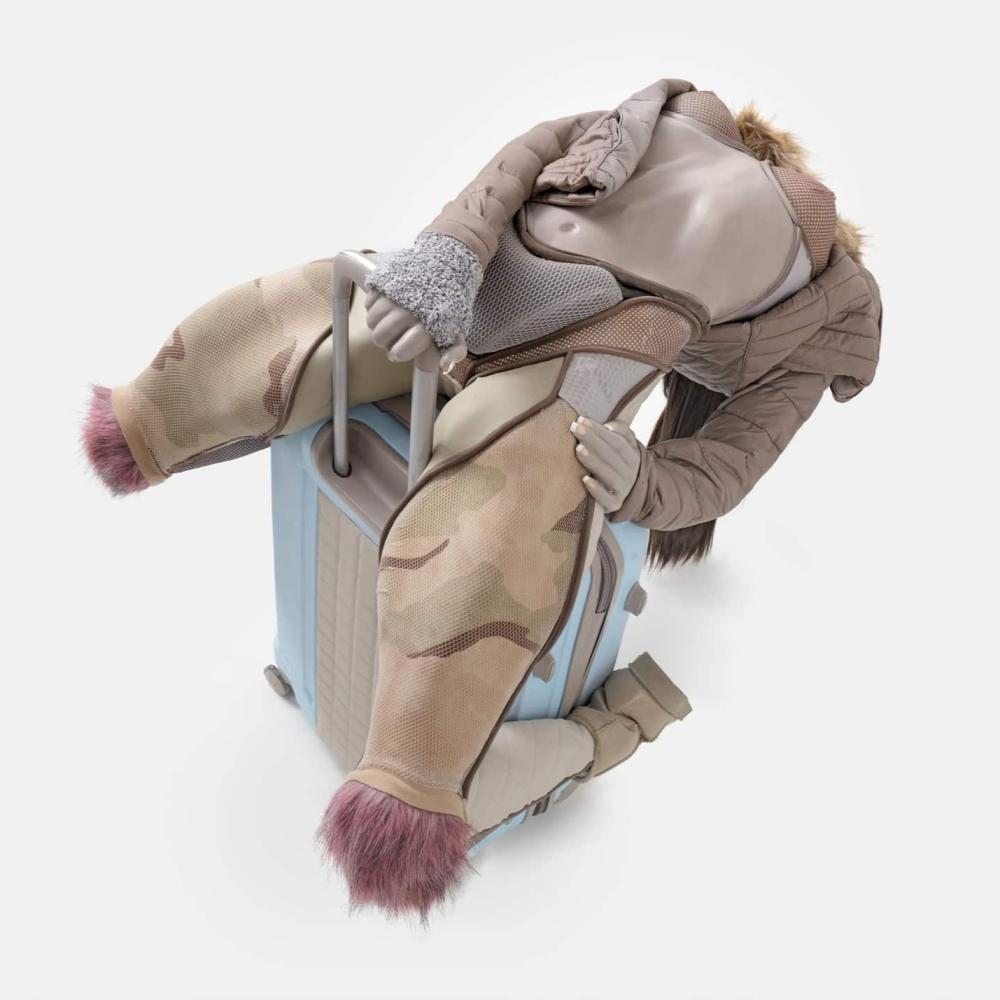
You are a painter, graphic designer, illustrator, book author and also a theatre and performance artist. How do you balance all of your artistic identities?
It's all original work that comes out of me. I say similar things with all my work, I just try different means. For example, professional illustrators or set designers have it much harder, every month, quarter, or however long they work on one thing, they have to completely retune themselves to a different train of thought of a different artist that they jump to. My identity is always the same, it doesn't change. Some might think I'm crazy for trying everything, and I don't have any schooling for any of it except fine art. I do writing, music and theatre very intuitively. But the common denominator is that I make paintings. Whether it's two-dimensional on canvas or paper, or three-dimensional scenic images in the theatre, or images that I describe through maybe a song or some text in a book.
Does the importance of these roles of yours change over time? For example, do you feel more like a painter when you are preparing an exhibition of paintings?
It is clear that what I am doing at the moment is the most important thing and I cannot be "jealous" of the other work I could be doing instead. It all depends on the conditions and challenges and what my particular options are. Of course, it's not that when the exhibition date is coming up, I paint for 14 days before the exhibition and then show it. It's mostly a stock of these painting or drawing works that are made on an ongoing basis. I then sort them into these thematic areas and then the exhibitions are made from them. For example, if there was a theatre performance coming up that wasn't improvised, there was an opportunity to rehearse it a couple of weeks beforehand, so I dedicated myself to theatre. But after the play was done, I went back to painting, because the next play wasn't due for another two months, for example.
So it's about working with time...
It's a little bit about working with time, but mostly about working with conditions. Because I'm doing more than one thing, I don't have a problem then if what happened a week ago happens - a piece of plaster fell off the ceiling in my studio and I basically couldn't paint. In another empty room that was going to be renovated, I took advantage of it and threw myself into the illustrations I was planning to do anyway. This time they are not illustrations for my text, but for a book by Jiří Dědeček and Petr Váša. In short, I'll just let myself be carried away by what's about to happen. When I stayed with my family in New York for a few months, I didn't have the space to work on bigger things there either. So for now I've been working on lyrics for books.
You were a member of the band Hardheads. Does the group still function in any way today? The last official joint presentation was in 2007 in Ostrava with a reprise in 2008 in Prague. Do you think that the group deserves a comeback or is it something that remains only in history?
Last year, after twenty years, I was again invited to the art symposium "Workshop" in Mikulov (the founding members of the symposium in 1994 were sculptors from the Tvrdohlaví group, including Petr Nikl, editor's note). The curator Jaroslav Róna decided to conceive the thirtieth anniversary year of the symposium as such a return and invited some of the former members of the Hardheads. We spent an intensive month there together, when we had the castle at our disposal and after a long time we spent time together with four other former members. I just didn't do anything for that whole month other than just paint. But the last exhibition while the group was still active was in 1991 at the Municipal Library in Prague. We disbanded the group there because both external and internal circumstances directed us elsewhere. Also in terms of ambition and promotion.
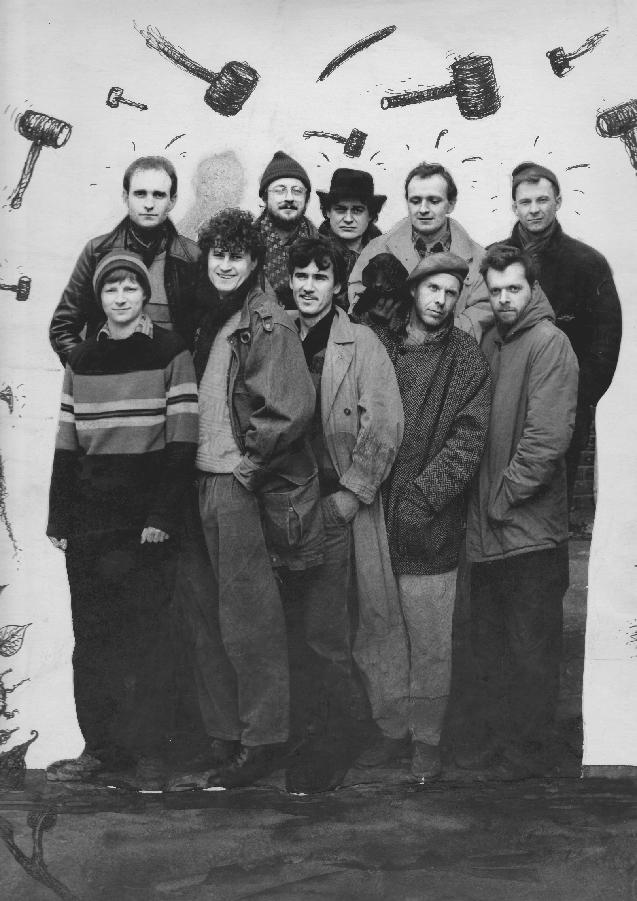
The change of regime probably played a role in it...
We started under totalitarianism and after the revolution the existence of the group didn't make so much sense to us anymore. At the same time, our works started to become more dispersed and we missed the archetypal link that was there in the 80s.
But it wasn't the end of the line, at the retrospective exhibition at the end of the 90s you reunited...
It was in 1999 at the exhibition TVRDOHLAVÍ IV in the Valdštejn Riding Hall in Prague. It was a little bit of a return in time, we exhibited things that were created while the group was still functioning, between 87 and 97, but also after the end of the group. So it was a kind of hard to grasp exhibition, since we didn't really exist anymore. It wasn't a comeback, it was more of a friendly reunion.
One of the former members, Jiri David, was not present at the time...
And that was because of the schism. The group, which no longer existed, actually had an exhibition under the same name, where not only works from when the group was active were exhibited, but also new works. The question of the name was something that all of us former members sort of dealt with at the time. We agreed that if we were to prepare an exhibition in the future, it would be historicizing, i.e. composed only of things that relate to the turn of the 80s and 90s.
Let's move to the present, the Signal IV exhibition is coming up, which is focused on a selection of works from the 80s from the Robert Runták Collection. Your works will be part of it. Where has your artistic expression moved since the 1980s, the time of the breakup of the Hardheads?
I am consistent in the themes I work on, although some new ones may be added. Rather, I've developed over time that strange simultaneity with other activities that weren't so uniformly run in those 80s. I was mostly involved in the visual arts at that time, although I already had a puppet theater and was composing something on instruments, but it was very intimate. I was also writing some lyrics at the time, which came out twenty years later, so I had some stock. But I would say it was all kind of simultaneous...
But the presentation of your work was rationed.
Yes, at that time, in the Hardheads era, my focus was in the visual arts. I also had a solo exhibition in 87, which was done by the Ševčíks in Prague. At that time I was understood and seen on the artistic side. Then after the revolution, other possibilities started to appear, for example the Archa Theatre opened and I could do not only puppet theatre but also visually experimental drama. So I started to do more performative work. At the same time, I was still composing some songs, but I didn't start performing publicly until the end of the 90s, and I waited until then because I was realizing myself in a different way. And after 2000 I started to publish books, mainly through Meander and Aulos. So it was kind of gradual, putting those non-art works of mine into the public domain. The important thing was that I started experimenting with projects that included theatre, concert and art experience. That's how the interactive project Nest of Games was created in 2000 at the Rudolfinum. And later the whole cycle of exhibitions Orbis pictus and Orbis pictus Play.
You also participated in the presentation of the Czech Republic at the World Expo 2005 in Japan...
Yes, I conceived the Garden of Fantasy and Music in the Czech pavilion in Aichi, Japan, based on this interactive principle. Going back to my development, it unfolded by exploring different visual possibilities, rather than trying other stylistic forms as an artist. In the beginning I did things that were realistic, then based on fantasy, then works that were completely automatic, which was the case with the drawings from the exhibition Connections (at the Telegraph Gallery from December 2023 to March 2024, ed.). And gradually I've come to a free position where I'm not working with my own hand, but I'm using a lot of that performative experience, and it's on the borderline of the theatrical experience of that immediate and completely spontaneous happening. In parallel with this, I think I will also "jump" back to painting an almost realistic painting, or a subject from fantasy. The connecting moment here is the inspiration of nature. In the classical sense, like many others, I am fascinated by the existence of natural things, and I explore this through flowers, plants, animal bodies or portraits of people. I am fascinated by the visuality of nature, which I alternate with the visuality of randomness. But because the randomness is created through natural processes, it's actually awfully close to nature.

You created the graphic Connections, which was created in collaboration with Telegraph Gallery as part of an on-site performance. It is a spontaneous pattern created by traces of electronic machines and toys.
I played with a variation of the word Connection. It was about connecting to a medium, connecting to a trust that if I let these electronic blobs do something on a tilted plane spontaneously, something interesting would emerge.
How did this technique actually come about?
I would compare it to, for example, the acoustic drawings that Milan Grygar did back in 1960. When I was born, a member of the Japanese group Gutai had this battery on a wheelchair that he used to go back and forth with, which would let the paint flow. It was something Pollock did by hand in America. It's nothing new to use something that leaves a mark. I was inspired by nature again. When one sees wormholes in the bark of trees or veins on a rock. I thought of them when I was buying these moving things in the toy store that don't have wheels but vibratory drive, or they just spin eccentrically and the movement is free and unexpected, and I started using them in shows and performances where they were unconsciously living with me on that surface and doing some kind of back or front plan. They annoyed me by the way I couldn't control them. And that's what I liked. One day I noticed that they left a trail in the grits I was using in the performance, similar to the trail of a living organism. So I started experimenting with sprinkling pigments on the paper and letting the toys run over it and leave a trail. Then when the rest of the pigment was blown away, it created a drawing similar to an energy map. At first, I thought it was just going to be a crazy abstraction for me to throw away after the show. But when I saw how imaginative the abstractions were, I got all starry-eyed and started thinking about what to do with them. And that's how I got to the point where I started attaching little bowls of ink to various massagers or vibrating toothbrushes, maybe with string or some other way, so that they could leave marks.

How long have you actually been doing this technique?
It's been ten years and I still haven't gotten the hang of it. There are many times I've thought I could give it up, but each time there's some other level of the map that ex post suggests some patterns that I didn't cause, I just helped to create, which is still an interesting process for me. Similarly with the ink-sprayed stuff, where I tilt the plane and let the water run off and dissolve the ink into the rice paper, which sucks a lot. And it's also uncontrollable where the water goes, because it's just as uncontrollable a natural process. And that's why it creates things that look a lot like natural formations. But this technique, which wouldn't have meant anything to me before, I only gradually worked my way into it, through my other activities, through performances and improvisations in them. There was no plan to do things that were absolutely automatic. Until then, I was making things automatic in the sense that my hand was making them, which I was trying not to follow with my mind, maybe not to look at it, or just to fiddle with it, and then only to find out what it actually came to be and to be further inspired by it. Something that wasn't done by my hand I had never tried before. That journey is behind the graphic Connections, which was created as part of a performance to accompany the Connections exhibition.
What are you planning in the coming months or years? What are you up to next and what are your artistic ambitions?
I don't make any plans or have any ambitions. Because I know that the best will come on its own, without any will. It's some kind of working principle where one thing comes out of another step by step and I don't really know where it will lead me. That's how it excites me and it's adventurous for me. But it doesn't preclude a different approach, where a lot of people work with the idea that they have a vision first and then they make it happen. Which I also have partly at first, but I try to leave a lot of space in there so I don't cling too much to what I've worked out in advance. So that there is that possibility of connecting that spontaneity, whether partial or complete. I'm only learning what it is in the process. For example, when I paint a portrait based on a photo I took myself, I can see what I'm doing. But by building, for example, a certain light there, something else is created beyond that, it's not just a colouring of the photo. It's a kind of immersion into time, space and light. It's a way of meditation where I'm with time and with existence and I don't have any plans, I'm kind of spread out. I'm planning an exhibition for which I'm going to prepare something in a certain time frame, I don't know exactly what yet. Today I was just thinking that the curator Pavel Lagner wanted me to make more paintings for the upcoming exhibition at the Václav Špála Gallery, because the last exhibition was more of a performance project, but my thinking about the exhibition is based on the specific conditions and how the environment can be taken into play. I'm not tired of just moving finished works from one place to another, just taking something away, adding something. But I like more site specific work for a given place and time, and using the material I have at the moment, and what I can think of to try with it at the time.






